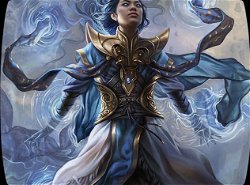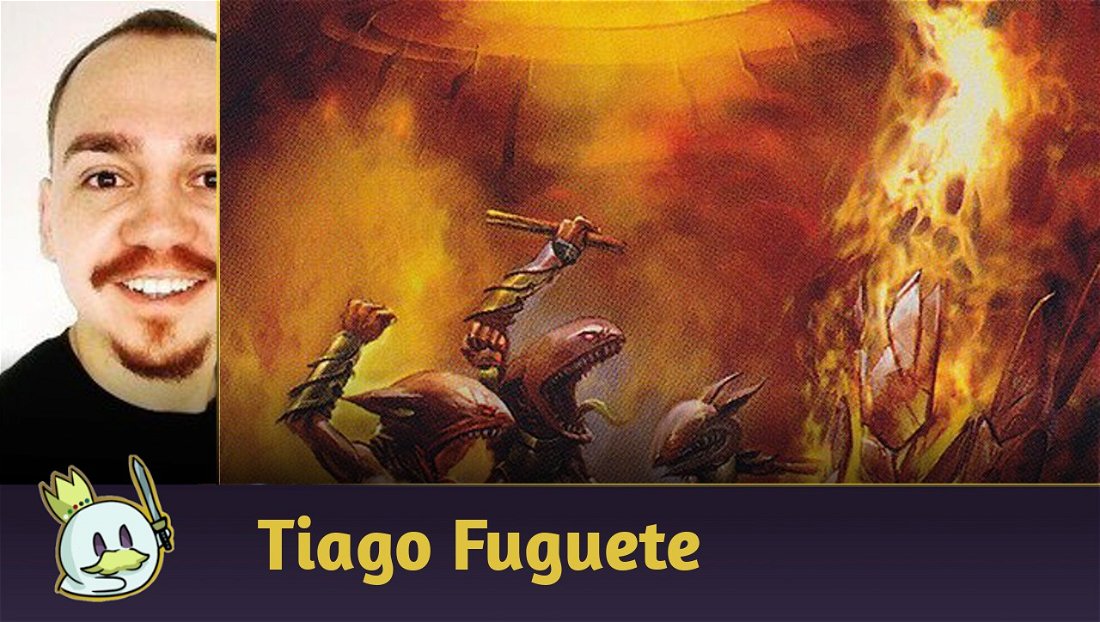The Pioneer Challenger Decks 2022 had their decklists revealed, featuring four different archetypes: Izzet Phoenix, Orzhov Humans, Gruul Aggro and Dimir Control — each with a distinct strategy and ready to play out of the box, making it perfect for tournaments at local stores.
The main focus of this product is to serve as a gateway for players to enter an eternal format without the need to incessantly search for older cards that aren't always easily available, guaranteeing them the experience of enjoying the format from an unopened box found at any local store.
Unlike what we did last year, where we analyzed the four decks and gave upgrade tips, in this one we will review each one individually, with an in-depth view of what is the proposal that the list, coming straight out of the box, seeks to provide and which ones directions we can take based on its content.
Today, we are going to look at the most reactive among them, Dimir Control.
Out of the Box - Dimir Control
Of the four decks in this release, Dimir Control is the hardest to rate as good or bad because, as the name implies, it's a Control. This archetype tends to need to adapt to a given Metagame to succeed, looking for the right answers for each situation. So depending on the setting at your local store or the event you attend, the out-of-the-box list can be either great or terrible.
That said, despite some dated choices, its list is solid enough for you to understand the principles it proposes and play well against Aggro and Midrange, and has some decent spells for the Control mirror on the maindeck, and even more preparation for this matchup on the Sideboard.

With a total of 12 removals, luckily with four copies of Fatal Push and two of the others, it manages to hold its own against Aggro long enough for a sweeper to clear the board, severely punishing go wide, like Humans, while the other removals punish Midranges that seek to use larger creatures or Planeswalkers.
Extinction Event was a good choice of sweeper for the maindeck, both for exiling creatures (and therefore dealing with recurring threats like Arclight Phoenix), and for offering some flexibility in keeping an important creature on board. That said, this Challenger Deck would have been a great opportunity to reprint The Meathook Massacre.

The number of Counterspells is also on par with what we've seen in the event lists over the past few months, including maindeck copies of Negate, as a flexible way to deal with a variety of problematic spells and permanents, and it also has Mystical Dispute as an unexpected one-of for the mirror match.

Th cantrips and draw spells package is also good enough and on par with what we've come to expect from competitive lists, with Consider filtering the top and helping to fuel Dig Through Time, while Narset, Parter of Veils operates as yet another powerful card selection. Perhaps a copy of Memory Deluge could be included, but three copies of Dig Through Time also do a good job in an archetype that purports to extend the game.
However, this is where the praise for the deck that comes straight out-of-the-box ends.

The original list only has three winconditions: two Torrential Gearhulk and one Shark Typhoon. There is nothing else capable of winning the game in a few turns, not even a man land like Hall of Storm Giants has been added to improve this point. That is, you have three cards to take your opponent's life from 20 to 0, and if they are killed and/or countered, you will be forced to rely on Murderous Rider's beatdown to win, which is a horrible game plan.
Dimir Control's core is excellent for what it sets out to do, but it just doesn't seem to want to win. It lacks enough elements to provide resilience in more interactive games without needing to stretch further than the player would like or feel necessary, and is designed to make games obscenely long. An extra copy of Shark Typhoon and some manland, even an inferior one like Crawling Barrens, would do enough to make the "winning games" factor more tangible on this list.

Speaking of manabase, it also leaves something to be desired: its only dual playset is Temple of Deceit which, let's face it, is a decent option for Control. However, with just two Drowned Catacomb and one Watery Grave, the deck doesn't seem to have enough consistency to pay all its mana costs in the first few turns without occasionally struggling.
The list features Field of Ruin as an extra disruption against greedy manabases that helps correct your curve. However, four copies seem like a lot, as you hardly want two of them in your starting mana or first land drops, and Fabled Passage or even Evolving Wilds could be included as 2-ofs in their place to improve the recurrence of colors needed in the first few turns, as well as interacting with Dig Through Time and Fatal Push.

The Sideboard has some specific answers for each occasion. However, despite Duress being a good disruptive option, this list fails to capitalize on its effect due to the absence of a good clock.
On the other hand, Test of Talents is a good answer against certain combos when responding to cards like Sylvan Awakening in Four-Color Ascendancy and other options against Lotus Combo, and Mystical Dispute is a while excellent play when your opponent is attempting to tap out each turn.

It also offers some good sweepers against Aggro, such as Cry of the Carnarium, but without neglecting the possibility of having to deal with larger creatures with Languish.
Overall, except for the occasional issues with discards like Duress, its sideboard feels like an extension of the maindeck for specific games, and probably offers the flexibility that each matchup requires.
Overall, Dimir Control is a good purchase due to its efficient base. But, unlike Gruul Aggro or Orzhov Humans, it is not intuitive, and the player needs to understand very well how it operates and what are the right moments to play its threats to avoid the risk of not having the means to win the game.
Upgrades Guide
Interestingly, the Dimir Control is the list that simultaneously needs more changes and fewer changes than the others. It follows a proposal of its own, and what differs is exclusively what kind of winconditions you want to run.
And in the case of the list above, the option is the classic version with Shark Typhoon and Planeswalkers alongside Torrential Gearhulk, but another option could include the versions with Thing in the Ice and Narset, Parter of Veils' combo with Day's Undoing.
But first, let's get to the manabase.
Maindeck
IN:

OUT:

Temple of Deceit, while decent, is inflexible and slow for the purpose we're looking for in more competitive variants, so we replaced it with Clearwater Pathway for coming into play untapped, plus two copies of Fetid Pools, a dual that interacts with Castle Vantress and Drowned Catacomb while being more useful in late-game.
Watery Grave is needed if you want to increase the number of Drowned Catacomb, and we've also replaced two Field of Ruin with Castle Vantress, to help filter our top on later turns, and Blast Zone as a comprehensive answer for various situations. Finally, we also added Hall of Storm Giants as a working late-game wincondition.
IN:

OUT:

You can keep Murderous Rider if you like, but Ertai Resurrected is a better option on most occasions due to its flexibility. Two more copies of Shark Typhoon seems necessary to ensure consistency in your winconditions, and we removed Censor as both are spells that can be used with pseudo-cantrips at certain stages of the game.
Finally, Dimir Control will hardly be able to play three copies of Dig Through Time with ease, so we chose to add an extra wincondition with Hullbreaker Horror, a permanent capable of overpowering Control mirrors and/or punishing severely the Midranges if the match goes on too long.
IN:

OUT:

Drown in the Loch is a bad card in a format where all players are trying to cast Treasure Cruise, or attacking graveyards with Graveyard Trespasser, or playing with cards above their expected mana curve. So, we replaced it with Eliminate to deal with low-cost creatures and Planeswalkers, and Disdainful Stroke as a maindeck answer against big mana that also solves other problems like Sheoldred, the Apocalypse.
In addition to these options, there are a number of Maindeck pieces that are flexible to your Metagame, and you can replace them with more useful options as needed in your local scenario. All the cards below are viable options in Dimir Control's maindeck and sideboard, and it's up to the player to understand which ones suit their needs.

Sideboard
IN:

OUT:

As with Maindeck, the amount of answers depending on what you intend to face is also wide. In the example above (which you can opt out of if you prefer), I sought to expand the range of spells on the Sideboard to have a way to play around different situations in an unfamiliar Metagame.
Dimir Control with Upgrades
With the above changes, your list will look like this. You can later look for other winconditions like the aforementioned Thing in the Ice, as well as other useful Sideboard pieces and threats like Kalitas, Traitor of Ghet and Sheoldred, the Apocalypse, as well as more specific counterspells such as Narset's Reversal.

Conclusion
Dimir Control offers a solid core to what it proposes. However, their lack of means to win the game can also create situations where the player needs to make sub-optimal choices in order not to lose their few means of establishing a clock. It seeks to be too sure of the opponent not having an answer, which is not always the case, and perhaps the inclusion of manlands and more copies of Shark Typhoon would help in that regard.
The improved deck is a solid option for Pioneer, but extremely dependent on the Metagame you're playing in. Therefore, I cannot recommend it to any player as it requires an extensive understanding of the format. However, it's not so complicated that you can't play it straight out of the box if you know key game concepts like Card Advantage and have some idea of how a Control should behave.
Thanks for reading!














— Comments 0
, Reactions 1
Be the first to comment